75% consumers feel children are being misled in many advertisements for apps, gaming and other online services
- • 87% consumers say they have difficulty in reading, viewing and hearing disclaimers
- • 86% have come across child inappropriate ads in the last one year
- • 73% consumers have come across bait advertising in the last one year
- • 49% have come across advertisements of free products with administration and shipping charges
- • Consumers urge the Government to change definition of consumer to someone who may have not necessarily bought a product but also who is a prospect so complaints for misleading ads don’t require a transaction
- • LocalCircles submits collective consumers inputs on advertising code to Dept of Consumer Affairs per the October 1 public feedback deadline
October 2nd, 2020, New Delhi: During the pandemic months, a series of advertisements were flagged by the consumers as misleading including products like mattresses, sanitizers, fabrics, readymade garments, juices, breads and even ice creams as immunity building for COVID-19 or fighting the COVID-19 virus. In August this year, LocalCircles had release a consumer study on misleading ads which had received over 67,000 responses and the findings of the study were submitted to the Department of Consumer Affairs. Through the survey, consumers had raised strong concerns via LocalCircles about a series of misleading advertisements before and during the COVID-19 pandemic. 75% consumers had said they had come across celebrity ads which were misleading, while 80% consumers had said ads should be regulated by a Government body instead of an industry body which does not have penal powers. Consumer had said with Consumer Protection Act 2019 notified now, an advertisement code must be developed and enforced to minimise such misleading ads
Post the LocalCircles study, in late August, the Ministry of Consumer Affairs issued a draft for ‘Central Consumer Protection Authority (Prevention of Misleading Advertisements and Necessary Due Diligence for Endorsement of Advertisements) Guidelines, 2020 aimed at preventing unfair trade practices and protecting consumers’ interest. These guidelines or rules once applicable to the manufacturers, service providers and businesses whose products/services are subject of the advertising & marketing communications, as well as to the advertisement agency and endorser of products/services. The Government had set a revised deadline of 1st October for the public to give their feedback on the draft policy.
LocalCircles converted this draft into some more easy to understand and participate questions to get feedback of common consumers on this draft policy. The combined survey on advertising code received over 115,000 responses from consumers spread across 320+ districts of the country.
In the first question, consumers were asked how they found the disclaimers to be in print, television, radio and digital ads. 65% said the disclaimers were very difficult to hear, view and read, while 22% said they were somewhat difficult to hear, view and read. Only 7% said that the disclaimers were quite clear. Many consumers have reported how the disclaimers after ads are rushed in and generally presented in a faster tone than the advertisement itself and generally comes across as something that brands do not want consumers to hear and are doing so for the sake of it.
87% consumers find disclaimers in advertisements difficult to read, view and hear

This means that 87% consumers find disclaimers in advertisements difficult to read, view and hear. The draft guidelines clearly state that a disclaimer should not attempt to correct a misleading claim made in an advertisement and should be clearly visible to the consumer. Non-legible disclaimers will also be considered as misleading ads.
The next question asked in the last 1 year, where have they come across advertisements that are inappropriate for children. In response, 19% said television, 4% said in general video sites like YouTube, while 27% said both of the above. 2% said newspapers while 34% said all three of the above mediums i.e. television, general video sites and newspapers. Only 4% said none of these and 10% said they were unsure.
86% consumers have come across child inappropriate ads on television, digital sites or newsprint in the last 1 year
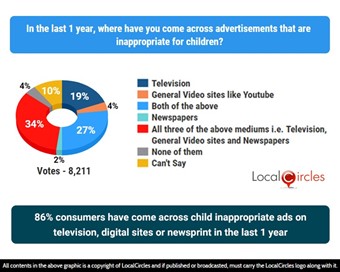
This shows that around 86% consumers have come across child inappropriate ads on television, digital sites or newsprint in the last 1 year. Consumer reported how on video sites child inappropriate ads are presented between children videos and how sites should only show ads based on the video content being watched.
Consumers were also asked in the last 1 year, what has been their experience with bait advertising or advertising of products at exceptionally low prices/good deals. 47% said product was advertised at exceptionally low prices but wasn't available at that price when visited store/app/website, while 27% said product was advertised at exceptionally low prices and was available at that price when visited store/app/website. 26% said product was advertised at exceptionally low prices and was available at that price when visited store/app/website but there were additional conditions.
73% consumers have come across bait advertising in the last 1 year where what was advertised was different than what was actually available
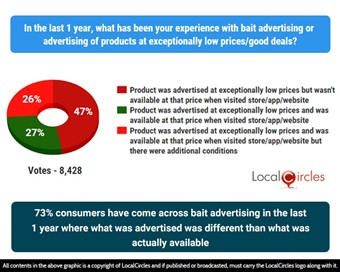
This clearly shows that nearly 73% consumers have come across bait advertising in the last 1 year where what was advertised was different than what was actually available.
75% consumers have come across ads of apps, games and online products/services that were designed to mislead children into spending
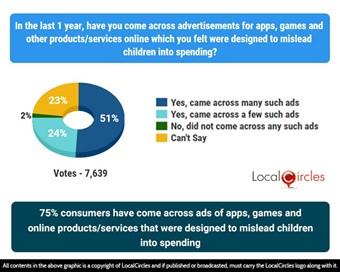
When asked in the last 1 year, have they come across advertisements for apps, games and other products/services online which they felt were designed to mislead children into spending, 51% said ‘yes, came across many such ads’ while 24% said ‘yes, came across a few such ads’. Only 2% said they did not come across any such ads, while 23% were unsure about it.
On this front, the draft says that the ad should not take advantage of children's inexperience, credulity or sense of loyalty, or exaggerate the features of a good or service in a way that could lead to children having unrealistic expectations of such good or service, and include a direct promotion to children to purchase a good or service or to persuade their parents to purchase a good or service for them.
The result of this poll points out to the fact that 75% consumers have come across ads of apps, games and online products/services that were designed to mislead children into spending.
Consumers were also asked if in the last 1 year, they have come across ads for free products where they have to pay for packaging, handling or administration of the free product. 20% said they have come across many such ads while 29% said they have come across a few such ads. 46% said they did not come across any such ads.
49% consumers have come across ads in the last 1 year where a free product was offered with charges for packing, packaging, handling and administration
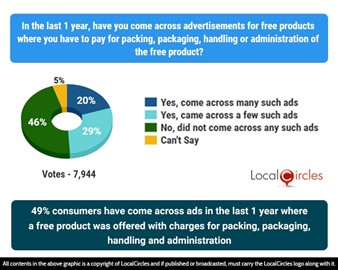
The data shows that 49% consumers have come across ads in the last 1 year where a free product was offered with charges for packing, handling and administration. Over the last few years, the way in which people consume ads has drastically changed and there has been a major shift towards digital advertisements that are put out though thousands of websites, including Facebook, Twitter, Instagram, YouTube etc. and hence it becomes necessary that these platforms are also monitored for misleading ads. Over the last 3 years, LocalCircles has received thousands of complaints about digital ads that offer to sell something at exceptionally low prices and at times free and a credit/debit card is taken for charging administration or shipping charges. In many of these cases per consumer complaints, the charge is levied but the product doesn’t arrive.
When asked if the Government should also prohibit advertisements from gaming platforms especially the ones where an individual can earn or lose money (similar to gambling), 77% said yes while only 18% said no.
77% consumers want Government to prohibit advertisements for getting platforms where one can earn or lose money
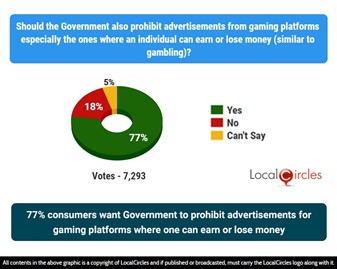
On 18th September 2020, media reports appeared stating that Google removed some fantasy gaming apps stating that we don’t allow online casinos or support any unregulated gambling apps that facilitate sports betting. This includes if an app leads consumer to an external website that allows them to participate in paid tournaments to win real money or cash prizes, it is a violation of our policies. Apps like Dream 11, myteam11, mycircle11 etc. which call themselves ‘skill-based gaming platforms’, also encourage people to spend money on their platforms in a bid to win more money.
Many parents have objected to as to how heavy advertising by these fantasy gaming platforms during Indian Premier League has led to children becoming curious and starting to enrol with such platforms. 77% of the consumers in the survey want a ban on advertising for fantasy gaming platforms. Some others demanded that they be put in the same category as sin products and be permitted surrogate advertising.
In the earlier set of questions, consumers were asked about the level of trust they have in ads in print, TV, digital and other forms of media. Only 3% said they had a high level of trust while 25% said they had an average level trust in ads. 48% said low and 23% said they had zero trust in advertisements
Only 28% consumers have trust in advertisements
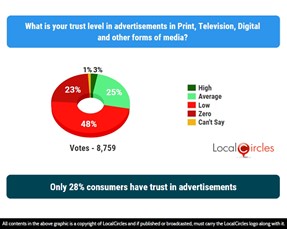
Consumers find most misleading advertisements in cosmetic products/services and real estate sector
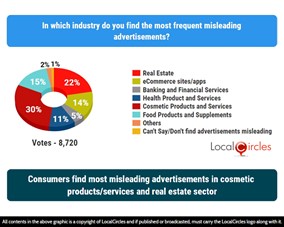
When asked in which industry they find most frequent misleading ads, 22% said real estate, 14% said ecommerce sites/apps, 5% banking and financial services and 11% health products and services. 30% said cosmetic products and services while 15% said food products and supplements. 2% said others.
Consumers were also asked if, in the last 12 months, they had come across ads (print, TV or digital) that were vulgar in nature. 60% said yes and 29% said no.
60% consumers say in the last 12 months they have come across one or more vulgar advertisements
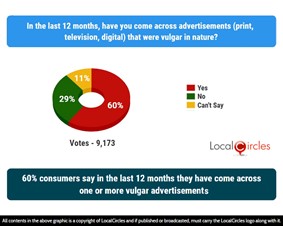
Surrogate advertising is a form of advertising which is used to promote products like cigarettes, tobacco and alcohol, in the guise of another product. People were asked if surrogate or substitute advertising should be permitted for products like liquor, cigarette and gutka, where direct advertising is banned. 76% said it should not be permitted while only 19% said it should be permitted.
76% consumers believe surrogate advertisements should not be permitted for products that are banned from being advertised
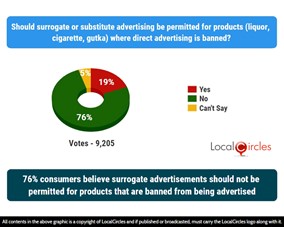
The next question asked if in recent years people had come across advertisements by a celebrity which they later discovered to be false or misleading. 75% replied in a ‘yes’ while 11% said ‘no’.
75% consumers say they have come across a celebrity advertisement which they later discovered to be misleading or false
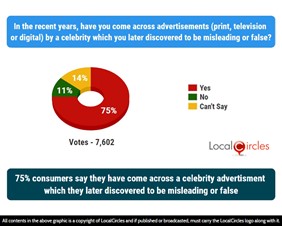
Following question asked in recent years, what kind of losses have they or their family incurred as a result of relying on an advertisement which they later discovered to be misleading or false. 10% said they had incurred a financial loss while 21% said they have incurred both financial and health losses. Just 1% said they had incurred loss of health and 2% have incurred a loss of life. 10% said they have not incurred any loss and 53% said they don’t rely on advertisements.
Majority of the consumers who rely on advertisements have faced some kind of loss due to them
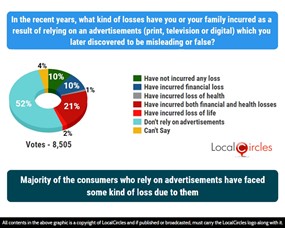
The final question asked consumers how the regulation of misleading ads can be made more effective given that it is currently done through an industry body by the name ASCI. 11% said it is already effective and the current self-regulation system should continue while 80% said it should be regulated by a Government body instead. 3% respondents said advertisements should not be regulated at all.
80% consumers want regulation of misleading advertisements to be done by a Government body instead of an industry body
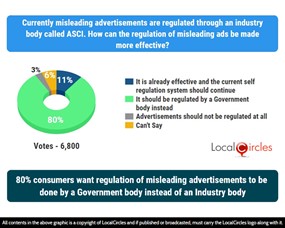
In addition to the above issues, consumer raised some additional pertinent points to be included before the draft advertising code is finalised. Consumers said that with Consumer Protection Act 2019 notified, the advertisement code with rules (and not a mere guideline) must be developed and enforced to minimise such misleading ads. Also, hundreds of consumers pointed out that advertising code must qualify anyone as a consumer who has bought a product or anyone who has seen an advertisement and has found an issue in it. Many consumers highlighted that most of the regulations require a transaction to be done for a brand to held accountable and action taken by the authorities and that prevents actions from being taken in many cases of misleading advertisements. Instead, anyone who has seen a misleading ad and is reporting the same must be considered a prospective buyer and the draft advertising code should consider all such complaints and action them.
LocalCircles has submitted this feedback from consumers to the Department of Consumer Affairs requesting them to consider these inputs as they finalise the Advertising Code of India
Survey Demographics
Over 115,000 responses were received from consumers residing in 320+ districts of India. 71% respondents were men while 29% respondents were women. 51% respondents were from tier 1, 34% from tier 2 and 15% respondents were from tier 3, 4 and rural districts. They survey was conducted via LocalCircles platform and all participants are validated citizens who had to be registered with LocalCircles to participate in this survey.
About LocalCircles
LocalCircles, India’s leading Community Social Media platform enables citizens and small businesses to escalate issues for policy and enforcement interventions and enables Government to make policies that are citizen and small business centric. LocalCircles is also India’s # 1 pollster on issues of governance, public and consumer interest. More about LocalCircles can be found on https://www.localcircles.com
Akshay Gupta - media@localcircles.com, +91-8585909866
All content in this report is a copyright of LocalCircles. Any reproduction or redistribution of the graphics or the data therein requires the LocalCircles logo to be carried along with it. In case any violation is observed LocalCircles reserves the right to take legal action.


